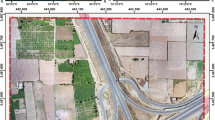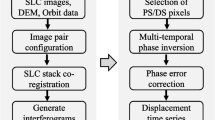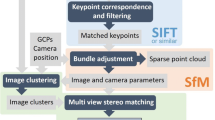Abstract
Synthetic aperture radar (SAR) is a newly-developed remote sensing technology that works in all weather and independent of daylight. Recent satellite designs such as TerraSAR-x, which have resolutions of a couple of meters and sub-meters, have provided appropriate data for modelling and monitoring of urban areas. Image classification and height information extraction is possible considering the nature of SAR data. In this paper, a proper classification method for high-resolution SAR images has been used in urban areas. This classifier is based on statistical models. First, statistical models that are well adapted to urban SAR images are selected. Initial labelling is performed using the maximum likelihood method. A method based on Markov random fields is applied to improve the results by considering neighbourhood information. Meanwhile, topographic information is extracted using the phase difference obtained from SAR interferometry. After classification and height extraction, the homogeneous regions consisting of locations with similar objects are determined. The homogeneous region adjacency graph are generated using vectors containing classification information, extracted objects, height of pixels forming each region, and information on the neighbouring areas. Height and classification information are then merged by assigning height conditions based on the nature of objects and optimizing an energy function. The results obtained, including buildings, streets, and corner reflectors, are easily recognizable. The overall accuracy is improved from 57% in the initial classification to 95% in the employed procedure. Moreover, the accuracy of height estimation is about 2.74 m, which is acceptable for height estimations of buildings with more than one floor.









Similar content being viewed by others
References
Christian, W. (2007). Hand-book on statistical distribution for experimentalists. Stockholm: University of Stockholm.
Hanssen, R. (2001). Radar interferometry: Data interpretation and error analysis. Dordrecht: Kluwer Academic Publisher.
Lisini, G., Tison, C., Cherfi, D., Tupin, F., & Gamba, P. (2004). Improving road network extraction in high resolution SAR images by data fusion. Paper presented at the GEOS SAR workshop, Ulm, Germany.
Luckman, A., & Grey, W. (2003). Urban building height variance from multibaseline ERS coherence. IEEE Transactions on Geoscience and Remote Sensing, 41(9), 2022–2025.
Quartulli, M., & Datcu, M. (2004). Stochastic geometrical modeling for built-up area understanding from a single SAR intensity image with meter resolution. IEEE Transactions on Geoscience and Remote Sensing, 42(9), 1996–2003.
Richards, J. A. (2013). Remote sensing digital image analysis. Berlin: Springer.
Sefercik, U. G. (2013). Productivity of TerraSAR-X 3D data in urban areas: A case study in Trento. European Journal of Remote Sensing, 46, 597–612.
Sefercik, U. G., & Ozendi, M. (2013). Comprehensive comparison of VHR 3D spatial data acquired from IKONOS and TerraSAR-X imagery. Advances in Space Research, 52, 1655–1667.
Simonetto, E., Oriot, H., & Garello, R. (2005). Rectangular building extraction from stereoscopic airborne radar images. IEEE Transactions on Geoscience and Remote Sensing, 43(10), 2386–2395.
Soergel, U. (2010). Radar remote sensing of urban areas. Berlin: Springer.
Soergel, U., Michaelsen, E., Thiele, A., Cadario, E., & Thoennessen, U. (2009). Stereo analysis of high-resolution SAR images for building height estimation in case of orthogonal aspect directions. ISPRS Journal of Photogrammetry and Remote Sensing, 64(5), 490–500.
Tison, C., Nicolas, J. M., Tupin, F., & Maitre, H. (2004a). A new statistical model for Markovian classification of urban areas in high-resolution SAR images. IEEE Transactions on Geoscience and Remote Sensing, 42(10), 2046–2057.
Tison, C., & Tupin, F. (2010). Estimation of urban DSM from mono-aspect InSAR images. A chapter of radar remote sensing of urban areas. Paper presented at IGARSS 2004 IEEE International Geoscience and Remote Sensing Symposium. Springe.
Tison, C., Tupin, F., & Maitre, H. (2004b). Retrieval of building shapes from shadows in high-resolution SAR interferometric images. Presented at IGARSS’04 (Vol. III, pp. 1788–1791).
Tison, C., Tupin, F., & Maitre, H. (2007). A fusion scheme for joint retrieval of urban height map and classification from high-resolution interferometric SAR images. IEEE Transactions on Geoscience and Remote Sensing, 45(2), 496–505.
Tupin, F., & Roux, M. (2005). Markov random field on region adjacency graph for the fusion of SAR and optical data in radargrammetric applications. IEEE Transactions on Geoscience and Remote Sensing, 43(8), 1920–1928.
Acknowledgements
We wish to thank German Aerospace Center (DLR) for providing TerraSAR-X data under Project LAN1085.
Author information
Authors and Affiliations
Corresponding author
About this article
Cite this article
Sharafzadeh, A., Esmaeily, A. & Dehghani, M. 3D Modelling of Urban Area Using Synthetic Aperture Radar (SAR). J Indian Soc Remote Sens 46, 1785–1793 (2018). https://doi.org/10.1007/s12524-018-0827-6
Received:
Accepted:
Published:
Issue Date:
DOI: https://doi.org/10.1007/s12524-018-0827-6




